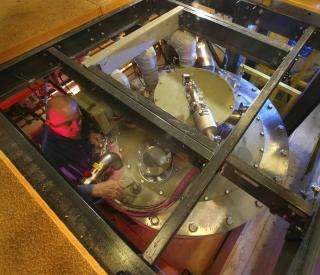One-of-a-kind magnet open for science

The world's most powerful pulsed, nondestructive magnet is now ready to explore the frontiers of high magnetic field science - after 10 years of research, major instrument development, and construction.
The National High Magnetic Field Laboratory at Los Alamos National Laboratory has completed the 100 Tesla Multi-shot Magnet, capable of the highest magnetic fields ever produced nondestructively on a repetitive basis.
"Tesla" is a unit of magnetic flux density, or the strength of a magnetic field in a given region, named for 19th-century electrical engineer Nicola Tesla.
The magnet is commissioned for user operation at 85 tesla and will over time be made available at higher fields, depending upon materials development and consistent with user demand. Located at the National High Magnetic Field Laboratory's Pulsed Field Facility at Los Alamos, the project is jointly supported by the Department of Energy's Office of Basic Energy Sciences and the National Science Foundation's 100 Tesla Multi-Shot magnet program.
"Achieving fields above 85T nondestructively and repetitively marks a major milestone in magnet design and materials engineering as man-made fields of this strength have never before been produced without the use of highly destructive, explosives-driven, magnetic field-generating technologies," said NHMFL - Los Alamos Center Leader Alex H. Lacerda.
The magnet is now part of the NHMFL science user program, also supported by the National Science Foundation. Scientists and engineers from academia, government laboratories, and industry will have access on a competitive basis to the highest magnetic fields ever produced nondestructively on a repetitive basis.
With this new capability, researchers can explore uncharted regimes of low temperature and high magnetic field, central to understanding the mechanism of superconductivity, magnetic field-induced phase transitions, and so-called quantum critical points, in which small changes in materials properties at very low temperature have dramatic effects on physical behavior.
"The NHMFL 100T Project is an excellent example of teamwork among scientists, engineers, and government agencies. 100T has been goal for many years world-wide," said Lacerda. "The scientific environment at Los Alamos was of paramount importance in this achievement. I'm also particularly pleased by the continuing support from DOE and NSF to this long and exciting project."
The National High Magnetic Field Laboratory develops and operates state-of-the-art, high-magnetic-field facilities that faculty and visiting scientists and engineers use for research in physics, biology, bioengineering, chemistry, geochemistry, biochemistry and materials science. The laboratory - with campuses in Tallahassee and Gainesville, Florida, as well as in Los Alamos - is sponsored by the NSF and the state of Florida and is the only facility of its kind in the United States.
Source: Los Alamos National Laboratory





















